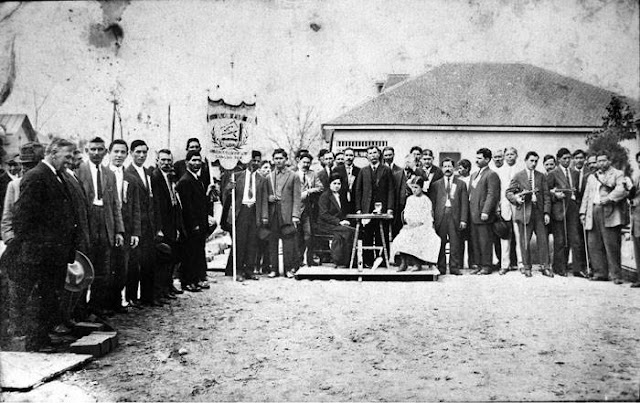 |
| image source: U.S. Mint |
After more than three quarters of a century, Jovita Idár is in the news again. Only this time, she is the subject, not the writer. Jovita will be one of five women recognized by the U.S. Mint in the 2023 American Women Quarters Program. (Learn about the other four women.) Her image will be found on a U.S. quarter. Maybe you've never heard of Jovita Idár. If not, continue reading to learn about this fierce, intelligent, and compassionate role model we have in our history. Scroll down to find my printable lesson plan. To learn about other remarkable figures, check out my post on Latinos in History Your Children Should Know.
Who was Jovita Idár?
Jovita Idár was born in the border town of Laredo, Texas, in 1885. Jovita’s family was one of the few middle class Mexican families. Passionate about education and civil rights, Jovita’s father, Nicasio Idár raised his kids to be highly educated and with a strong sense of social justice.
The second of eight children, Jovita excelled academically. It’s no surprise that she started off as a teacher. But she became frustrated with the lack of resources available to Mexican students and the one-sided curriculum that omitted or demonized Mexican figures and culture. She understood the lasting damage this did to Mexican children who learned that being white was good and being brown was bad. Before long, she decided that she would be more effective at creating social change as a journalist fighting for equal education and the civil rights of Mexican families. She began working for La Crónica, her family’s newspaper. Nicasio was proud of his daughter’s outspoken character and encouraged her interest and involvement in politics.
In her weekly articles, Jovita protested the racist, anti-Mexican culture that permeated not just her border town, but also throughout Texas and the Southwest. Signs refusing service to “Mexicans and dogs” were often hung in storefronts. Segregation was strong. And voter intimidation - frequently through violent killing and mutilations - was common.
It’s important to note that Jovita did not restrict her articles to her father’s paper. She frequently wrote for other Spanish-language newspapers throughout her life, oftentimes under pseudonyms, such as “Ave Negra” (Black Bird) and “Astrea” (the Greek goddess of justice).
 |
| Jovita Idár and members of Union of Stone Mason and Bricklayers, Laredo, Texas, ca. 1915, General Photograph Collection, UTSA Special Collections. |
The First Mexican Congress
In 1911, Jovita and her family organized the First Mexican Congress - El Primer Congreso Mexicanista - in response to the lynching of a 14-year-old boy. The goal was to find solutions to the inequalities and racism that existed for Mexicans and Mexican Americans. It also strove to unite Mexicans on the issues they faced and create a unified front to fight for their rights and better living conditions.
The event had a huge turnout with officials and citizens from both Mexico and Texas attending. It is regarded as one of the largest Mexican-American civil rights gatherings of the time.
Unsurprisingly, Jovita ensured that women were central to the event and not only helped to organize it, but were speakers, too.
The League of Mexican Women & the White Cross
Shortly afterward, Jovita also founded La Liga Femenil Mexicanista (the League of Mexican Women), which she modeled after the Mexican Congress. It’s goals were to engage and empower Mexican women, support women’s suffrage, teach adult literacy classes, and champion quality education for Mexican children. She served as its first president and their first project was providing free bilingual education to Mexican children from poor families. Its members were highly educated women and mostly working class who learned about politics so they could improve conditions in their communities.
Jovita saw the fluidity of living in a border town and sought to rally families on both sides of the border. Fully bilingual, she understood that the success of Mexican families required change in both countries. She left her journalism behind and served in the White Cross (founded by her best friend Leonor Villegas de Magnon) when the Mexican Revolution made its way across the Texas border in 1914.
A couple of years later, Jovita was able to hang up her nurses’ uniform and return to her love of journalism when she began writing for El Progreso newspaper. After the paper ran an editorial criticizing President Woodrow Wilson's order to dispatch U.S military troops to the Mexico–United States border, Texas Rangers showed up at the newspaper, armed and ready to close it down. But Jovita herself barred entry and refused to let them enter while boldly quoting their First Amendment rights to freedom of the press. (They returned the next day when she was gone and smashed the printing press to bits.)
The First Latina Newspaper Owner
Two years later, in 1916, Jovita purchased her own printing press and started her own Spanish-language newspaper called La Evolución in which she continued to expose the discrimination Mexicans experienced. It was probably the first Latina-owned newspaper in the United States.
 |
| Wedding portrait of Bartolo Juarez and Jovita Idar, General Photograph Collection, UTSA Special Collections. |
Five years later, Jovita’s brother, Eduardo, took over the running of the paper when Jovita moved to San Antonio with her husband, Bartolo Juárez. But Jovita didn’t stop her crusade for social justice. Together, they founded the Democrat club. And they quickly became leaders in the community. As such, Jovita embraced civic engagement and gave back to her community by founding a free kindergarten, volunteering as an interpreter at the local hospital, and assisting undocumented workers in getting their naturalization papers.
Jovita Idár Juárez died in San Antonio from tuberculosis on June 3, 1946.
She was fierce and intelligent and compassionate. What a wonderful role model we have in our history.
Get the Lesson Plan
- essay questions,
- project based learning options,
- and research & present topics.


